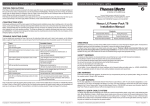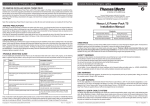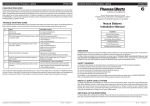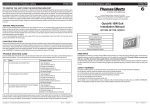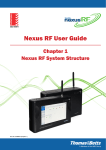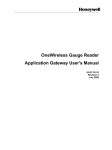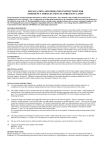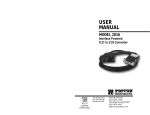Download LED Legend Recessed Exit Installation Manual
Transcript
Complete Solutions in Emergency Lighting STANILITE Complete Solutions in Emergency Lighting STANILITE Doc No: 29-00070 TESTING PRECAUTIONS If the unit is to be left permanently connected to the mains supply from now on, you will need to allow it one day (24 hours) to charge its battery and then you will have to conduct a manual discharge test as per the requirements of AS/NZS2293.2. Presently (at the time of writing), the standard requires that unit’s operate in emergency mode for a period not less than 2 hours for their first test upon installation and for not less than 90 minutes thereafter once every 6 months. You will need to keep the records for the initial test and enter them into the building emergency services logbook. If the unit isn’t permanently connected to mains supply at this time, you are responsible to give it the initial 2 hour test when you do connect it permanently to the mains supply. Thomas & Betts Australasia. ABN 062 074 810 898 Head Office: Unit D3, 3-29 Birnie Avenue, Lidcombe NSW 2141, Australia Manufacturing: 23a Nyrang Street, Lidcombe NSW 2141, Australia Telephone: (+61) 1300 666 595 Facsimile: (+61) 1300 666 594 LED Legend Recessed Exit Installation Manual CONSTRUCTION SITES Continuously switching on and off the unit’s mains supply during the installation process (due to building works or for some other reason), could cause the unit’s to discharge and charge their batteries many times over a short period. This may shorten the life of both the battery and the lamp/s. Thomas & Betts does not recommend such practices and may not honour any warranty on the life of the batteries or the lamps when subjected to such harsh operating conditions. The unit’s are designed to be regularly discharge tested once every 6 months as per AS/NZS2293.2. Deliberate consistent discharge testing is considered an abuse of the fittings. Contents What’s Inside the box Electrical Safety Warning Recessed Base Assembly Installation Instructions Diffuser Assembly TROUBLE SHOOTING GUIDE Removal Method Ceiling Cut-out Template Testing Precautions Pictograph Diffuser Insert Pack Trouble Shooting Guide Mains Power Cord If you’ve installed and connected the unit as per the instructions listed earlier and it doesn’t work properly, use the following table as a guide to fixing the problem. Look up the type of fault in the left column and check the possible causes from the right column. # Fault Possible Causes Installation Brochure 1 LED lamp and indicator LED not lit AC supply not connected; or AC supply turned off; or Test switch damaged Data Plug (For Nexus product only) Cable Ties 2 LED lamp not lit but red indicator LED is lit LED lamp damaged; or LED lamp plug incorrectly inserted in the mother board 3 LED lamp not lit but indicator LED is flashing green LED lamp damaged; or LED lamp plug incorrectly inserted in the mother board 4 LED lamp is lit but red indicator LED not lit LED damaged; or Check battery connection 5 The LED lamp doesn’t switch to emergency mode when the test button is pressed Test switch damaged 6 LED is constant green Test switch damaged; or Self check fail - return to factory 7 LED not red after commissioning Check battery connection and battery plug polarity 8 The LED lamp works momentarily on emergency when the test button is pressed or tested by command from the Nexus system Battery not yet charged (allow up to 24 hours) Warranty Information GREETINGS Congratulations on choosing to use this Thomas & Betts product covered by our unique Through-Life Support system. This document is designed to assist you during the installation of this product, so for the safety of yourself and others Thomas & Betts recommends that you read this document thoroughly before commencing installation. The LED Legend Recessed range of fittings are designed to be installed quickly. These are advanced pieces of electronic equipment and when treated with due care and maintained through regular and appropriate servicing, will perform without trouble for many years to come. SAFETY WARNING In Australia and New Zealand, only licensed electricians are permitted by law to work with 240 Volt electrical installations. Do not attempt to install or connect this product unless you are a licensed electrician. Turn off and isolate the electrical supply before connecting this fitting to the building wires. Do not touch the terminals of the terminal block when the light fitting is energised. Do not tamper with the fitting or the warranty will be void. As the installer, it is your responsibility to ensure compliance with all relevant building and safety codes, (ie: AS3000, AS/NZS2293). Refer to the applicable standards for data and mains cabling installation procedures and requirements. If the unit still doesn’t work after checking these possible causes, contact Thomas & Betts Service in Australia on 1300 666 595, Monday to Friday, 8.30am to 4.30pm (AEST) and ask for help. Our trained service personnel will usually be able to take your call immediately and assist you in resolving your difficulty. Thomas & Betts is committed to providing valuable Through-Life Support for its products. NEXUS LX (DATA CABLE SYSTEM) The Nexus range of light fitting are designed to be connected together into a special communication network over a Level 4 (or higher) high speed data single twisted pair cable. The Nexus LX User & Technical Guide describes all you need to know to successfully install a Nexus project. Ask for it from your supervisor, from your employer or from your nearest Thomas & Betts product supplier. The network cabling of the building must be installed as per the procedure detailed in the Nexus LX User & Technical Guide. No mains or mains carrying cables are to be connected to the data terminals or cables. NEXUS RF (WIRELESS SYSTEM) The Nexus RF range of light fitting are designed to be connected together into a special RF communication network. The installation of a product is no different to the Nexus or the standard product. The commissioning of the Nexus RF product is done by Thomas & Betts service personnel, please contact the Product Support Hotline for more information in Australia on 1300 666 595. © Copyright 2013. Thomas & Betts Australasia ABN: 062 074 810 898. Rev: 5.0 15 April 2013 4 © Copyright 2013. Thomas & Betts Australasia ABN: 062 074 810 898. Rev: 5.0 15 April 2013 1 Complete Solutions in Emergency Lighting STANILITE INSTALLATION INSTRUCTIONS 1. Remove the unit from the packing box and inspect it for damage or imperfections. If any damage is found, do not install the unit, but replace it carefully into the packing box and notify the Thomas & Betts Product Support Hotline in Australia on 1300 666 595. 2. If all looks okay, proceed for installation. Please note circuit suppling mains power to the fitting must not be energised until installation of the fitting is completed. Take out the cut-out template (348mm x 97mm) from the packing box; use a pencil to mark the cut-out position on the ceiling. Once the ceiling cut-out is done, remove the face plate, recess the base assembly through the ceiling cut-out (if access to the ceiling cavity is not available, connect the mains power cord and nexus data cable, secure with the cable ties supplied, before recessing the base in the ceiling cut-out). The Nexus yellow data cable is only connected for the Nexus unit (part number PLRNXSLED). Once recessed in the cut-out, tighten the cam lock screws using suitable size Philips screwdriver or a power driven screwdriver set at minimum torque, turning clockwise (refer Figure 1), to secure the product to the ceiling. Connect the mains power cord and Nexus data cable if not connected earlier and secure with the cable ties supplied. Figure 1: Tight cam lock screw using Philips screwdriver Figure 2: Product installed in ceiling 3. Once the base is secured to the ceiling, hold the diffuser assembly in your hand and connect the diffuser wire loom polarised plug to the mother board (refer Figure 3), the white wires on the plug should be towards the centre of the unit. Once the plug is connected, lay the wire loom carefully inside the base and place one side of the diffuser in the diffuser holding latch hole and push up the other side of the diffuser, the diffuser clicks and locks in place. Once the diffuser is locked in place, the face plate is easily fixed to the base. Hold the face plate in your hand; make sure the rectangular hole in the face plate for the LED and test switch lines up with LED and test switch in the base. Bring up the face plate close to the base, place the locking tab on one side in the position, the other end locking tab should line up on the correct position. Once both the locking tabs are in the correct position, press gently, till it clicks and locks. Press gently in the middle to lock middle two tabs, clicks sound indicates the tabs are locked in position. White Wires Diffuser Holding Latch Complete Solutions in Emergency Lighting STANILITE 4. Install the pictograph inserts by sliding into the diffuser. The pictograph inserts can be installed in the diffuser prior to installing the diffuser assembly in the fitting. Fitting is supplied standard with all pictograph insert options for single and double sided, as a complete one box solution to meet any site/project needs. 5. The circuit suppling mains power to the fitting can now be energised. Once powered up, in a single point unit red LED lamp should energise and remain lit on mains, until the power supply fails. For Nexus product the normal initial uncommissioned status of the indicating LED on the unit is flashing green. Once commissioned, the LED changes to a steady red and flashes red during test when receives commend from the Nexus system. Please refer to the Nexus LX/RF User & Technical Guide for a full detailed description of all possible LED states and their meanings. The emergency function of the fitting should only operate when the normal lighting power supply fails or when somebody presses the manual test button located on the unit or when commissioned on the Nexus network and the unit receives a command from the Nexus controller to switch into emergency mode. 6. Check the operation of the unit to ensure that the installation was successful. When powered up, allow a few minutes to give the battery a small charge, then press the manual test button located on the unit. Hold the test button in for a few seconds and observe the operation of the lamp switching from mains to the emergency mode. If the lamp on emergency mode works momentarily, that’s okay. Try again in a few more minutes because if the battery was completely discharged, it may take a little time to charge up enough to operate even momentarily. After this time, press the test button again and if the lamp doesn’t work at all, check the supply, the connections and the trouble shooting guide at the end of this document. 7. Once manually checked as per item 6 above, the Nexus unit is ready to be communication tested and commissioned into the Nexus network and registered in the database. Keep the information details of this unit including exact location description, DB and CB numbering, channel and router numbering, plan number and cross referencing information as all this will be required for entry into the database during commissioning. Refer to the Nexus LX/RF User & Technical Guide for full details. As the installer, it is your responsibility to conduct the initial discharge testing of the installed unit. Refer to AS/NZS2293. TO REMOVE THE UNIT FROM THE CEILING To remove/uninstall unit from the ceiling, the steps to be followed are the reversal of installation process. Turn off mains power to fitting, the fitting will automatically switch into emergency mode as the mains power has been turned off. It will stay on in the emergency mode until such time as the battery cut-off threshold is reached. Remove face plate, gently insert a small screwdriver into the first slot (first slot is close to the diffuser end) and pull down gently, repeat the same on the other end to remove face plate. To remove diffuser assembly, hold the diffuser holding latch with thumb on one end and push gently to the opposite end to remove diffuser from the holding latch. Once diffuser is removed from the latch, disconnect/remove wire loom plug from the mother board. Once the diffuser assembly is removed, disconnect the battery pack plug on the mother board. Mother Board Loosen the cam lock screws using suitable size Philips screwdriver or a power driven screwdriver set at minimum torque, turning anti clockwise. Once the cam lock screws are loosen, the recessed base assembly can be pulled down gently from the ceiling cut-out, pull out the mains power cord and the data cable plug (if Nexus) from the back of base. When the unit is reconnected to the mains supply, it will need time to recharge its battery before it will be capable of a full length discharge again. The ability of the unit to operate on emergency is determined by the age, charge level, operating temperature conditions and environmental circumstances of the battery in the unit. Figure 3: Connect wire loom plug to the mother board © Copyright 2013. Thomas & Betts Australasia ABN: 062 074 810 898. Rev: 5.0 15 April 2013 2 © Copyright 2013. Thomas & Betts Australasia ABN: 062 074 810 898. Rev:5.0 15 April 2013 3



